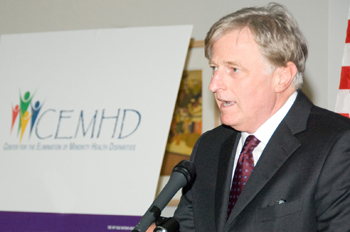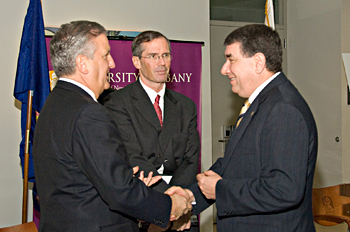$6.8 Million NIH Grant Bolsters UAlbany Center's Efforts to Reduce Minority Health Disparities in New York State
Contact(s): Catherine Herman (518) 956-8150
 |
CEMHD Director and UAlbany Professor of Anthropology and Epidemiology Lawrence Schell. (Photo Mark Schmidt) |
ALBANY, N.Y. (November 23, 2009) -- The University at Albany�s Center for the Elimination of Minority Health Disparities (CEMHD) has received a $6.8 million grant from the National Institutes of Health to advance and continue research aimed at eliminating health disparities in smaller cities throughout New York. The new grant will bolster the Center's research to improve access to health screening and quality health care for underrepresented groups, such as African Americans, Latinos and Native Americans. CEMHD projects also seek to promote healthy environments in small communities throughout the state, and provide information to New Yorkers about health maintenance.
The goals of the Center, founded in 2005, are to identify community needs, focus on barriers to health care and prevention programs, and develop specific projects with community groups to test programs that may reduce barriers and improve utilization of health-related services, and ultimately improve health.
"Increasing access to high-quality primary and preventive health care services for New Yorkers has been a focus of Governor David A. Paterson's historic health care reforms over the last two years," said Richard F. Daines, M.D., New York State Commissioner of Health. "This significant support from NIH for the University at Albany's Center for the Elimination of Minority Health Disparities will further break down barriers to care for many vulnerable and underserved individuals in the State. Greater access to services in the State's small cities and a better understanding of health care disparities will result in reduced numbers of hospitalizations among minority populations and a healthier New York."
"The Center for the Elimination of Minority Health Disparities fills an important need by developing effective community-based approaches for improving minority health in New York," said University at Albany President George M. Philip. "I congratulate Director Lawrence Schell and the esteemed research team of the Center for their tireless dedication to improving the health of communities throughout the State."
The projects include:
- Identifying successful strategies for overcoming barriers to reproductive healthcare encountered by low-income African-American women in small-town settings;
- A national analysis of racial, ethnic and economic disparities in health - over time and by place;
- Examining the impact of polychlorinated biphenyls (PCBs) and lead (Pb) on the reproductive health of Akwesasne Mohawk women living near the St. Lawrence River.
 |
From left, Albany Mayor Jerry Jennings, New York State Commissioner of Health Richard F. Daines, M.D., and UAlbany President George M. Philip were on hand to mark CEMHD's $6.8 million grant from NIH to reduce minority health disparities. (Photo Mark Schmidt) |
Researchers at the University at Albany will seek solutions to encourage greater numbers of African American women in small cities like Hudson, N.Y., to use services for reproductive health, including screening for breast and cervical cancer. CEMHD researchers are partnering with Upper Hudson Planned Parenthood and other community organizations to develop outreach programs for education and improved access to services.
"We are very excited to work with the University at Albany and the Center for the Elimination of Minority Health Disparities," stated Patricia McGeown, President/CEO of Upper Hudson Planned Parenthood. "This project will enable us to work with longstanding and new community partners to ensure that reproductive health services are accessible to all local residents, particularly those who may face significant cultural, income or geographical barriers."
"African-American women suffer significant disparities in disease incidence and health outcomes in relation to reproductive health, and we will evaluate intervention strategies that are specifically designed and may be especially effective in small cities and towns," said Schell. This project is led by associate professor Annis Golden and professor Anita Pomerantz of UAlbany's Department of Communication, with additional support from School of Public Health assistant professor Jennifer Manganello.
A second project, involving UAlbany's Department of Economics, will examine the nature of health disparities affecting multiple racial and ethnic groups in the U.S., including non-Latino whites, Latinos, African Americans, Asians, American Indians and native Alaskans, This study will look at how race, ethnicity and socioeconomic status are related to health over a 14-year time period and across communities of varying population size (rural to urban). Using data from the entire nation, researchers will examine whether health differences among racial and ethnic groups in small cites and towns are similar to what is often found in major cities, and whether differences have increased or decreased over time. Distinguished Professor Kajal Lahiri is project director and principal investigator, joined by co-investigator Pinka Chatterji and consultant Zulkarnain Pulungan.
The third part of the research series will examine whether the reproductive health of women of the St. Regis Mohawk Tribe on the St. Lawrence River has been adversely affected by toxins. The Akwesasne community is adjacent to one federal and two state Superfund sites affected by environmental toxins including PCBs and lead. The study will follow 180 women ages 21-35 through one menstrual cycle to investigate the effect of PCBs on their reproductive health, with the aim of improving health. Dr. David Carpenter, the director of the Institute for Health and the Environment at the School of Public Health, is co-principal investigator and lab director on this project. He is joined by co-investigator Mia V. Gallo (College of Arts and Sciences), associate professor Glenn Deane (sociology), and professor Cheryl Frye (psychology).
�Akwesasne has long been impacted by PCBs from neighboring industries,� remarked Tribal Chief James Ransom. �Women of child-bearing age are a particularly vulnerable at-risk group. We hope this research leads to improved health in our community and we thank UAlbany for the opportunity to participate with them on this important project.�
The Center has worked to build an inventory of existing health resources available to regional communities in Albany and Amsterdam, N.Y., and has developed partnerships with groups to assist in the dissemination of information to at-risk groups. Additionally, CEMHD has helped develop a health disparities certificate program designed to respond to the need for current and future leaders in public health, social services, medicine, and the social sciences (public health, social work, psychology, economics, health communication, and anthropology) to be knowledgeable of the issues and strategies needed to eliminate health disparities. The goal of this graduate program is to train current students and professionals in the field to be leaders in addressing health disparities by building community capacity and sustainability. These key initiatives have been coordinated and developed by associate professor of epidemiology David Strogatz, associate professor of social welfare Robert L. Miller Jr., and community outreach director Wilma Alvarado-Little.
![]() For more news, subscribe to UAlbany's RSS headline feeds
For more news, subscribe to UAlbany's RSS headline feeds
Educationally and culturally, the University at Albany-SUNY puts "The World Within Reach" for its 18,000 students. An internationally recognized research university with 58 undergraduate majors and 128 graduate degree programs, UAlbany is a leader among all New York State colleges and universities in such diverse fields as public policy, nanotechnology and criminal justice. With a curriculum enhanced by 300 study-abroad opportunities, UAlbany launches great careers. For more information about this globally ranked University, visit www.albany.edu. For UAlbany's extensive roster of faculty experts, visit www.albany.edu/news/experts.shtml.


